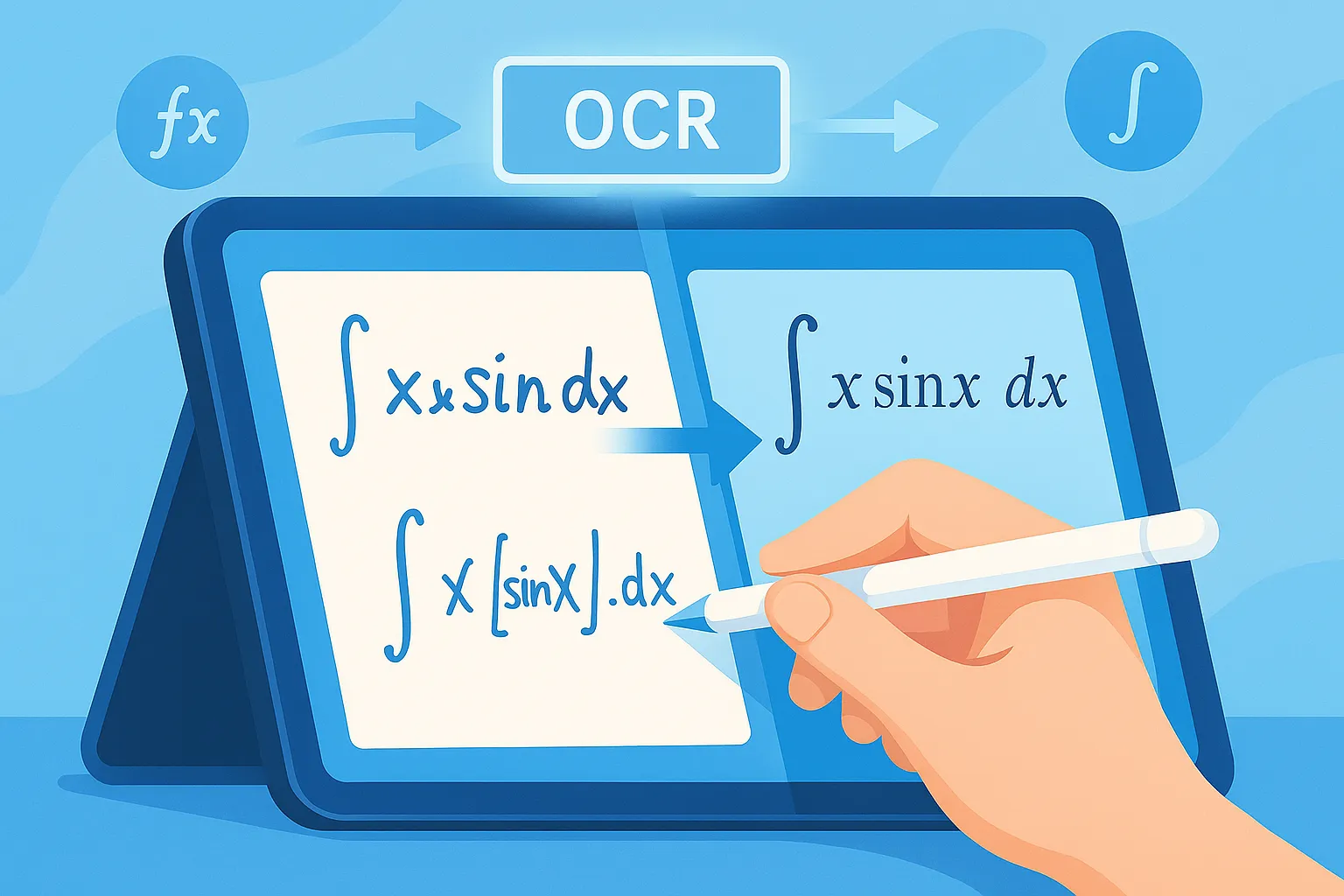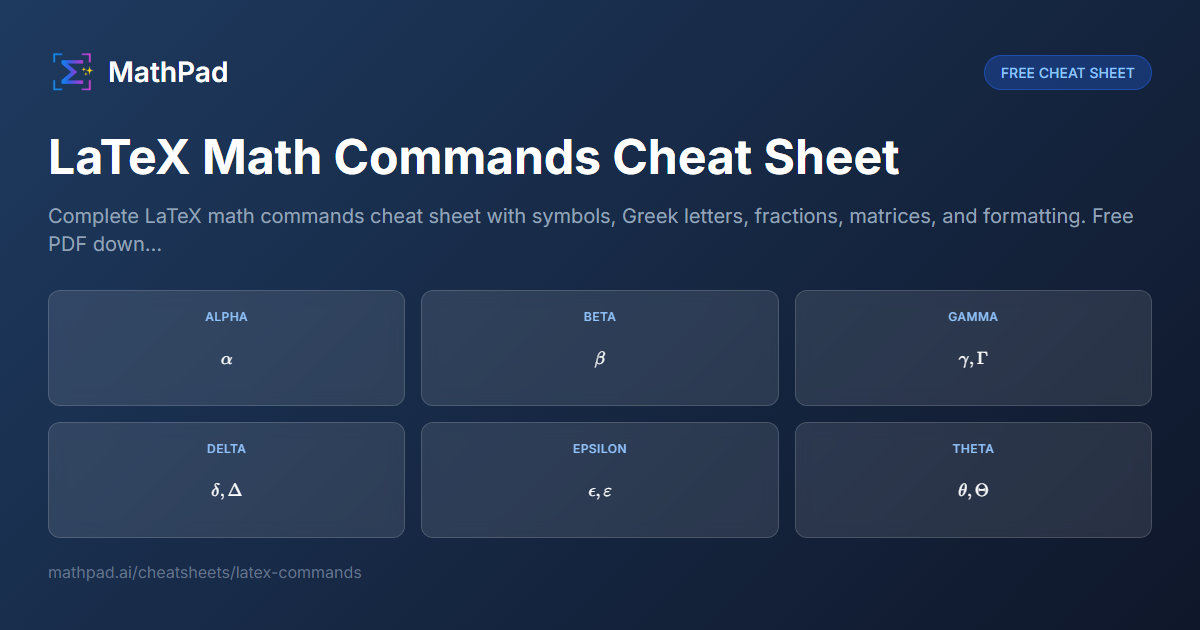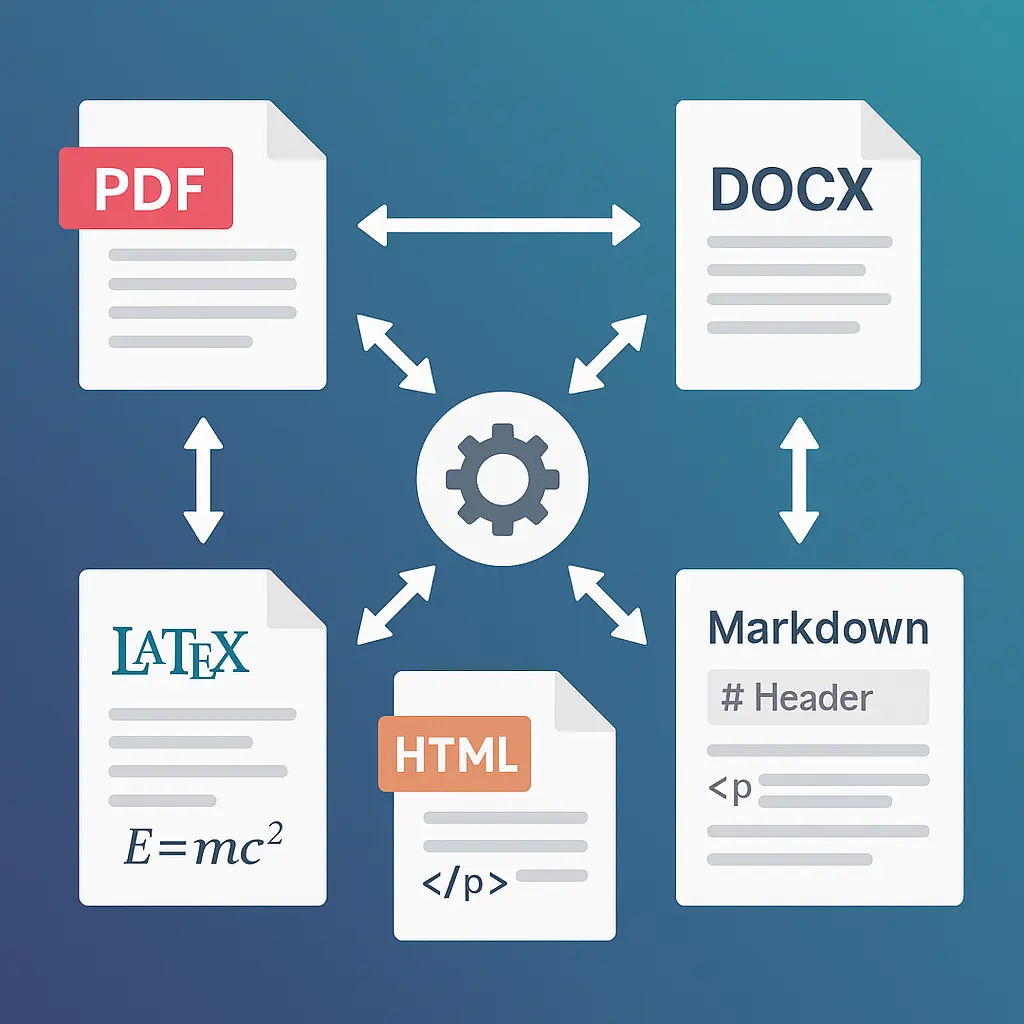Handwriting to LaTeX: Convert Your Math Notes Instantly (2025)
You write: ✍️ $\frac{-b \pm \sqrt{b^2-4ac}}{2a}$ (on paper/tablet)
AI converts to LaTeX:
\frac{-b \pm \sqrt{b^2-4ac}}{2a}
Result: Digital, searchable, editable, shareable math. ✨
This guide explains how handwriting-to-LaTeX conversion works, why LaTeX matters for math, accuracy tips for better results, and how MathPad's Digital Ink feature makes the process seamless.
📸 Ready to get unstuck? Try MathPad Free →
📋 Free Cheat Sheet: New to LaTeX? Get our LaTeX Math Commands Cheat Sheet with essential symbols and syntax.
Why LaTeX Matters for Math 📝
LaTeX = the language of mathematics
What is LaTeX?
Definition: A typesetting system for technical documents, especially mathematics.
Example:
E = mc^2
→ Renders as: E = mc²
\int_0^{\infty} e^{-x^2} dx = \frac{\sqrt{\pi}}{2}
→ Renders as beautiful formatted equation
Created: 1980s by Leslie Lamport (based on TeX by Donald Knuth)
Used by: Researchers, students, academics worldwide
Status: Industry standard for mathematical notation
Why Students Need LaTeX
1. Digital Homework Submission 📤
- Many online systems require LaTeX
- Copy-paste equations into Google Docs
- Submit typed homework (required by some professors)
2. Searchable Notes 🔍
- Find equations in your notes instantly
- "Search for quadratic formula"
- Can't search handwritten PDFs
3. Collaboration 🤝
- Share equations with study groups
- Tutors can edit and return
- Online forums (Math StackExchange) require LaTeX
4. Professional Documents 🎓
- Research papers
- Lab reports
- College applications (STEM portfolios)
5. Future-Proofing ⏳
- Handwritten notes degrade
- LaTeX files last forever
- Easy backups
The Traditional Problem
Before handwriting-to-LaTeX conversion:
You write: ✍️ $x = \frac{-b \pm \sqrt{b^2-4ac}}{2a}$
To digitize, you must TYPE:
x = \frac{-b \pm \sqrt{b^2-4ac}}{2a}
Time: 30-60 seconds per equation
Errors: Easy to mistype syntax
Frustration: High for complex equations
Now with AI:
You write: ✍️ (same equation)
AI converts: Instant LaTeX output
Time: 2-3 seconds
Errors: AI catches syntax mistakes
Frustration: Minimal
How Handwriting Recognition Works 🤖
The pipeline from handwriting → LaTeX:
Method 1: Photo-Based OCR
You write on paper → photo it → AI recognizes
Technology: Math OCR (see Math OCR guide)
Steps:
- Take photo of handwritten math
- Image preprocessing (straighten, enhance)
- Symbol detection (AI recognizes each character)
- Structural analysis (understand 2D layout)
- LaTeX generation
Accuracy: 90-95% (depends on handwriting quality)
Best for:
- Already-written notes
- Paper-based work
- Quick conversion
Method 2: Digital Ink Recognition
You write on tablet/touchscreen → AI recognizes in real-time
Technology: Stroke-based recognition
Steps:
- You write with stylus/finger
- AI captures stroke order and timing
- Recognizes patterns as you write
- Converts to LaTeX instantly
- You see both handwriting + LaTeX simultaneously
Accuracy: 93-98% (stroke data provides more info)
Best for:
- Real-time note-taking
- Interactive problem-solving
- Immediate digital output
Advantages over photo OCR:
- ✅ More accurate (has stroke order data)
- ✅ Real-time feedback
- ✅ Can correct as you write
- ✅ No photo quality issues
Digital Ink: The Superior Approach 🖊️
Why MathPad uses Digital Ink instead of just photo OCR:
What is Digital Ink?
Definition: Capturing handwriting digitally using:
- Stroke coordinates (where stylus/finger moved)
- Pressure data (how hard you pressed)
- Timing data (stroke order and speed)
- Pen angle (for advanced styluses)
vs Photo: Just pixels, no stroke information
Why Digital Ink is Better for Math
Photo OCR challenges:
- Is this $1$ or $l$ or $|$? (ambiguous)
- Which stroke came first? (unknown)
- Is this $x$ or $\times$? (hard to tell)
Digital Ink advantages:
- Stroke order reveals intent
- Timing data helps disambiguation
- Pressure indicates symbol boundaries
- Real-time processing enables immediate feedback
Example:
Writing × (multiplication):
- Stroke 1: ↘️ (diagonal down-right)
- Stroke 2: ↗️ (diagonal up-right)
- AI: "Two crossing strokes → multiplication symbol"
Writing x (variable):
- Stroke 1: ↘️ (diagonal down-right)
- Stroke 2: ↗️ starting lower (variable style)
- AI: "Variable x, not multiplication"
Photo OCR: Can't distinguish (both look similar in image)
Digital Ink: Can distinguish (has stroke data)
MathPad's InkScratchpad
Features:
1. Write Naturally ✍️
- Use stylus, finger, or mouse
- Write equations like on paper
- No special syntax required
2. Instant Recognition ⚡
- LaTeX appears as you write
- See both handwriting + typeset math
- Immediate feedback on recognition
3. Edit Handwriting ✏️
- Erase mistakes with eraser tool
- Select and delete strokes
- Rewrite unclear symbols
4. Edit LaTeX 🔧
- If recognition is wrong, edit LaTeX directly
- Manual override always available
- Best of both worlds
5. Copy to Workspace 📋
- One-click to insert into editor
- Seamless integration
- Continue working digitally
Accuracy Tips for Better Conversion 🎯
How to write for optimal recognition:
1. Write Clearly (Most Important) ✍️
Good handwriting:
- Legible to a human
- Distinct symbol shapes
- Consistent sizing
Bad handwriting:
- Rushed, messy strokes
- Ambiguous characters
- Overlapping symbols
Rule of thumb: If a human can't read it, AI probably can't either.
2. Space Symbols Appropriately 📏
Good spacing:
- Clear separation between symbols
- Obvious grouping (numerator/denominator)
- Consistent gaps
Bad spacing:
- Symbols touching or overlapping
- Unclear where one ends, next begins
- Cramped writing
Example:
Good: $x + 3 = 7$ (clear spaces)
Bad: $x+3=7$ (cramped, harder to parse)
3. Use Standard Notation 📐
Stick to common math notation:
Good:
- $\times$ for multiplication (standard)
- $\div$ for division
- Standard fraction layout
Avoid:
- $\cdot$ (dot multiplication) can be confused with decimal point
- Non-standard symbols
- Personal shorthand notation
AI is trained on standard textbook notation.
4. Write Exponents/Subscripts Clearly ⬆️⬇️
Make vertical offset obvious:
Exponent: $x^2$ (clearly above baseline)
Subscript: $x_2$ (clearly below baseline)
Same level: $x \cdot 2$ (multiplication, same height)
If AI misreads:
- Exaggerate vertical offset more
- Make superscript/subscript noticeably smaller
- Add more space from base character
5. Close Loops & Tails 🔄
Ambiguous characters:
6 vs b: Close the loop on 6, make b's tail clear
0 vs O: Slight tilt for O (letter), perfect circle for 0 (zero)
1 vs l vs |: Add base to 1, curvature to l (letter)
The fix: Exaggerate distinguishing features
6. Fraction Bars Should Be Long ➖
Good fraction:
x + 3
------- (long bar, clearly extends beyond numerator/denominator)
2
Bad fraction:
x + 3
----- (short bar, might be read as "x + 3 - 2")
2
AI needs clear horizontal line to recognize fraction structure.
7. Write at Moderate Speed ⏱️
Too fast: Strokes become messy, symbols ambiguous
Too slow: Breaks in strokes, disconnected parts
Just right: Natural writing pace, clear strokes
Digital ink tracks timing: Unusually slow/fast can confuse recognition.
Editing LaTeX After Conversion ✏️
Recognition is 95% accurate, but not perfect. Here's how to fix the 5%:
Common OCR Errors
1. Exponent misread as multiplication
What you wrote: $x^2$
AI read as: $x \times 2$ or $x2$
Fix: Edit LaTeX:
x \times 2 → x^2
2. Variable vs multiplication symbol
What you wrote: $2x$ (coefficient)
AI read as: $2 \times x$
Fix: Usually okay (mathematically equivalent), but if you want:
2 \times x → 2x
3. Parentheses vs absolute value
What you wrote: $|x|$ (absolute value)
AI read as: $(x)$ (parentheses)
Fix:
(x) → |x|
or more explicitly: \lvert x \rvert
4. Fraction layout errors
What you wrote: $\frac{x+3}{2}$
AI read as: $x + 3/2$ (misread structure)
Fix:
x + 3/2 → \frac{x+3}{2}
5. Greek letters
What you wrote: $\theta$
AI read as: $\theta$ ✓ or $0$ ✗
Fix: If misread as zero:
0 → \theta
Quick LaTeX Syntax Reference
Common structures you might need to edit:
Fractions: \frac{numerator}{denominator}
Exponents: x^{2} or x^2
Subscripts: x_{2} or x_2
Square root: \sqrt{x}
Nth root: \sqrt[n]{x}
Summation: \sum_{k=1}^{n} k^2
Integration: \int_{a}^{b} f(x)\,dx
Greek letters: \alpha, \beta, \theta, \pi
Absolute value: |x| or \lvert x \rvert
Parentheses: (x) or \left( x \right)
Pro tip: Learn basics → edit faster → save time.
📸 Ready to get unstuck? Try MathPad Free →
Use Cases: When to Convert Handwriting to LaTeX 💡
1. Lecture Notes → Digital Archive 📚
Workflow:
- Take handwritten notes in class (faster than typing)
- After class: Photo or digitize with tablet
- Convert to LaTeX using MathPad
- Store in digital notebook
- Now searchable + editable
Benefit: Best of both worlds (handwrite speed + digital benefits)
2. Homework → Online Submission 📤
Scenario: Professor requires typed homework
Workflow:
- Solve problems on paper (handwrite solutions)
- Convert each answer to LaTeX
- Copy into Google Docs or homework system
- Submit digitally
Time saved: 70% faster than typing LaTeX manually
3. Study Group Collaboration 🤝
Scenario: Working with remote study partners
Workflow:
- Work through problem on paper/tablet
- Convert to LaTeX
- Share in group chat or Google Doc
- Others can copy, edit, and respond
Benefit: Everyone can see and edit the math
4. Research Paper / Lab Report 🔬
Scenario: Writing paper with lots of equations
Workflow:
- Derive equations on paper (thinking process)
- Convert final equations to LaTeX
- Insert into paper template
- Professional-quality typography
Benefit: Focus on math first, formatting second
5. Tutoring Sessions 👨🏫
Scenario: Tutor explaining problem
Workflow:
- Tutor writes solution on tablet
- LaTeX generates in real-time
- Student sees both handwriting + typeset math
- Export to PDF and share with student
Benefit: Student gets perfect digital copy of session
6. Creating Flashcards 🗂️
Scenario: Making equation flashcards for studying
Workflow:
- Write equation on tablet
- Convert to LaTeX
- Use in digital flashcard app (Anki, Quizlet)
- Now searchable + can generate variations
Benefit: Digital flashcards > paper flashcards
MathPad's Complete Digital Ink Workflow 🚀
How it all works together:
Step 1: Open InkScratchpad
Location: Available everywhere in MathPad
Trigger: Click "Ink" button or pen icon
Interface: Full-screen writing canvas
Step 2: Write Your Equation
Tools:
- Pen (draw strokes)
- Eraser (remove mistakes)
- Clear all (start over)
- Undo/Redo
Write naturally: Like on paper, no special technique required.
Step 3: Real-Time Recognition
As you write:
- LaTeX updates below canvas
- See formatted equation render
- Immediate feedback
If wrong:
- Rewrite unclear symbols
- Erase and try again
- Or manually edit LaTeX
Step 4: Insert or Export
Options:
Insert to Editor: One-click to copy into main workspace
Copy LaTeX: Get raw LaTeX code
Solve with CAS: Send directly to solver
Share: Export as image or LaTeX
Step 5: Continue Working
Now in main workspace:
- Equation is editable
- Solve with CAS
- Use AI Tutor
- Generate practice problems
Full integration: Digital ink → LaTeX → CAS → solutions
Frequently Asked Questions
How accurate is handwriting-to-LaTeX conversion?
Accuracy ranges:
- Print-quality handwriting: 98%
- Clear handwriting: 93-95%
- Average handwriting: 85-90%
- Messy handwriting: 70-80%
Factors:
- Handwriting quality (most important)
- Symbol ambiguity
- Notation complexity
Bottom line: Very accurate for legible handwriting, always review output.
Do I need a stylus or can I use my finger?
Both work!
Stylus (Apple Pencil, Surface Pen):
- ✅ More precise
- ✅ Pressure sensitivity
- ✅ Better for small symbols
- Accuracy: 95%+
Finger (touchscreen):
- ✅ Always available
- ✅ No extra hardware needed
- ⚠️ Less precise (thicker strokes)
- Accuracy: 85-90%
Mouse (desktop):
- ✅ Works on any computer
- ⚠️ Hardest to write with
- Accuracy: 80-85%
Recommendation: Stylus for best results, but finger works fine.
Can I convert entire pages of notes at once?
Two approaches:
Approach 1: Page-at-a-time OCR
- Photo entire page
- AI processes all equations
- Outputs LaTeX for whole page
- Status: Not in MathPad currently (possible future feature)
Approach 2: Equation-by-equation
- Convert each equation individually
- More accurate (focus on one at a time)
- Status: Current MathPad workflow
Pro tip: For now, convert key equations one at a time for best accuracy.
What if the AI gets my handwriting completely wrong?
Solutions:
1. Rewrite more clearly
- Slow down
- Exaggerate symbol shapes
- Add more spacing
2. Edit LaTeX manually
- Click into LaTeX field
- Type corrections
- Override AI recognition
3. Type from scratch
- Sometimes faster for very messy handwriting
- Use keyboard input instead
4. Improve over time
- AI may learn your style
- Practice writing more clearly
- Develop "OCR-friendly" handwriting
Bottom line: Manual editing always available as fallback.
Does this work on iPad/tablet/phone?
Yes! MathPad is a PWA (Progressive Web App)
Device support:
- ✅ iPad (excellent with Apple Pencil)
- ✅ Android tablets (with stylus)
- ✅ Surface Pro / tablet PCs
- ✅ Phones (works but smaller screen)
- ✅ Desktops (with mouse/trackpad)
Optimized for:
- Touch input
- Stylus input
- Responsive design
Installation: No app store download needed, works in browser.
Can I export to Word/Google Docs?
Yes! Multiple export options:
1. Copy LaTeX code
- For systems that accept LaTeX
- Google Docs (with add-ons like Auto-LaTeX Equations)
- Overleaf, ShareLaTeX
2. Copy as image
- Rendered equation as PNG
- Insert anywhere (Word, PowerPoint)
- Not editable but universally compatible
3. Copy as Unicode
- Plain text with Unicode math symbols
- $x²$ instead of
x^2 - Quick but less formatting
Best workflow: LaTeX → Google Docs with Auto-LaTeX extension
How does this compare to typing LaTeX manually?
Speed comparison:
Typing manually:
\frac{-b \pm \sqrt{b^2 - 4ac}}{2a}
Time: 30-45 seconds (if you know syntax)
Errors: Easy to mistype, forget braces
Handwriting conversion:
- Write equation (10 seconds)
- AI converts (2 seconds)
- Review + minor edits (5 seconds)
- Total: ~17 seconds
Speedup: 2-3x faster
Learning curve: No LaTeX syntax knowledge required
When to type manually: Very simple expressions (x + 5)
When to convert: Complex equations with fractions, exponents, etc.
Will AI learn my specific handwriting over time?
Current state: No personalized learning (yet)
How it works now:
- AI trained on millions of handwriting samples
- Generic model applied to everyone
- No per-user adaptation
Future possibility:
- Personalized models that learn YOUR style
- Adapts to your notation preferences
- Improves accuracy over time
Workaround: You can learn to write "OCR-friendly":
- Identify which symbols AI misreads for you
- Adjust how you write those specific symbols
- Consistency helps
Can I use this for other subjects (chemistry, physics)?
Math: ✅ Full support (primary focus)
Physics:
- ✅ Equations work great
- ✅ Greek symbols (α, β, γ)
- ⚠️ Units (may need manual formatting)
Chemistry:
- ⚠️ Limited (not optimized for chemical formulas)
- Chemical structures: Not supported
- Simple formulas ($H_2O$): Works
Engineering:
- ✅ Math equations work
- ⚠️ Diagrams: Not supported
Bottom line: Optimized for mathematical notation. Other STEM subjects work partially.
Is handwriting-to-LaTeX free or paid?
MathPad pricing:
Free tier:
- 3 SnapSolves/day (includes OCR)
- Limited InkScratchpad use
Premium ($14.99/mo):
- Unlimited handwriting recognition
- Unlimited InkScratchpad
- All features unlocked
Alternatives:
- Mathpix Snip: $5/mo (photo OCR only)
- Detexify: Free (single symbol recognition)
Value: MathPad includes CAS solving + AI Tutor, not just conversion.
✨ Start solving smarter Try Free →
Related Topics
Continue your learning journey:
- Math OCR: How AI Reads Handwritten Math → – Deep dive into OCR technology
- Math Note-Taking App: Digital Handwriting → – Complete note-taking workflow
- Photo Math Calculator: Solve by Taking Pictures → – Photo-based solving workflow
- Math Solver with Camera: Mobile Guide → – Mobile-optimized handwriting capture
- Explore MathPad's Digital Ink → – InkScratchpad feature overview
- Try Digital Ink Now → – Start converting handwriting to LaTeX
Ready to convert your handwritten math to LaTeX instantly?
MathPad's InkScratchpad captures your handwriting with digital ink, converts to LaTeX in real-time, and integrates seamlessly with CAS solving and AI tutoring. Write naturally, get perfect digital output.




